Battle of the Garden Court
By Donald Lochbiler
It doesn't look like a one-time battleground.
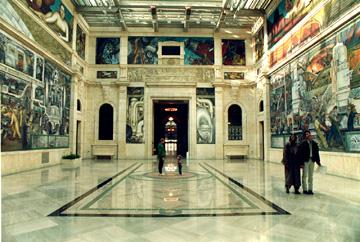
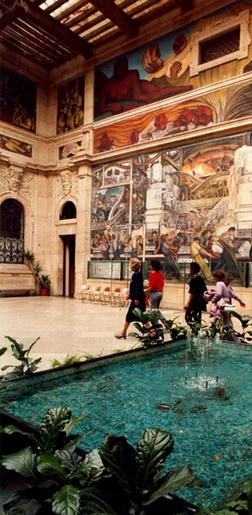
Nowadays, people who want to sit together and chat, and visitors merely resting their feet find the Garden Court at the Detroit Institute of Arts a pleasant place. Students linger there with their books. Some of the loungers study the murals on the walls by Diego Rivera, but most hardly give the frescoes a second glance.
It wasn't always so peaceful. When the murals were new, they were the center of a raging controversy.
The kindest disposition of them proposed by those who thought they were an outrage was that they be whitewashed over. This was the suggestion of the Rev. Ralph Higgins, senior curate of St. Paul's Cathedral. City Councilman William P. Bradley didn't think whitewashing was enough. Whitewash, he said, could be removed. Bradley demanded that the murals be erased completely from the museum walls; he branded them "a travesty on the spirit of Detroit."
The tumult was not foreseen by Dr. W. R. Valentiner, the institute's dignified director. He had long wanted to do something about the Garden Court's huge bare plaster walls. A Burne-Jones tapestry and a large painting by Augustus John hung there temporarily, but the effect left something to be desired.
Murals seemed to be called for. Valentiner recommended Diego Rivera, regarded as the world's foremost mural painter, for the job. The arts commission members were impressed by a showing of his drawings and watercolors. The Mexican artist was invited to come to Detroit.
Edsel Ford, one of the museum's greatest benefactors, agreed to underwrite the project's cost. It was announced to the public by Valentiner on June l0, l93l.
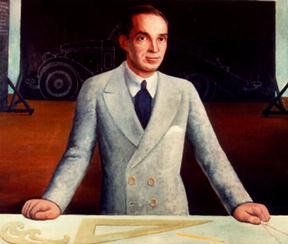
Three tons of lime arrived at the museum the following December, along with Albert Barrows, one of Rivera's assistants. The muralist himself arrived the following April, accompanied by his wife and two more assistants - Clifford Wight, a sculptor from California; and Lord Hastings, of the British peerage.
Plump and affable, Rivera weighed 316 pounds when he reached Detroit. He went on a diet and lost 108 of them in the 11 months he worked in the Garden Court.
It was clear that being an assistant to Rivera was no job for a dilettante. Rivera devoted several weeks to studying Detroit auto plants for inspiration, but once the work itself was under way Wight began operations at 3 a.m. to have wet plaster freshly applied to the museum walls by the time Rivera came to work at l0 o'clock.
Rivera drove himself, too. The section of wall prepared by Wight had to be entirely covered before the plaster dried. Sometimes Rivera put in as many as 20 hours at a stretch on his scaffolding, high above the floor of the Garden Court.
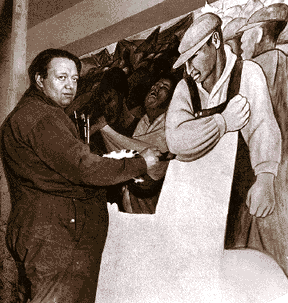
Members of the institute staff were amazed at his endurance. Through the long days of midsummer, when the temperature under the court's glass roof reached 120 degrees, he worked steadily.
He found his theme prowling odd corners of the city, visiting the neighborhoods of workmen's homes near the factories and the areas where ethnic groups centered their activities. He saw Detroit, he said as an expression of the steel that goes into automobiles and skyscrapers alike. On the walls of the Garden Court he represented the four elements most important in the making of steel by four major female figures.
"The yellow race represents the sand, because it is most numerous," he said. "And the red race, the first in this country, is like the iron ore, the first thing necessary for the steel.
"The black race is like coal, because it has a great native esthetic sense, a real flame of feeling and beauty in its ancient sculpture, its native rhythm and music. So its esthetic sense is like the fire, and its labor furnished the hardness which the carbon in the coal gives to steel.
"The white race is like the lime, not only because it is white, but because lime is the organizing agent in the making of steel. It binds together the other elements and so you see the white race as the great organizer of the world."
Even while Rivera put finishing touches on the smaller panels, the gates in the court were unlocked for visitors on St. Patrick's Day, 1933. The critical donnybrook began in a matter of hours.
An indignation meeting was called. One of the most vocal critics, Dr. George H. Derry, president of Marygrove College, summed up the objections this way:
"Senor Rivera has perpetrated a heartless hoax on his capitalist employer, Edsel Ford. Rivera was engaged to interpret Detroit; he has foisted on Mr. Ford and the museum a Communist manifesto. The key panel that first strikes the eye, when you enter the room, betrays the Communist motif that animates and alone explains the whole ensemble. Will the women of Detroit feel flattered when they realize that they are embodied in the female with the hard, masculine, unsexed face, ecstatically staring for hope and help across the panel to the languorous and grossly sensual Asiatic sister on the right?"
The arts commission met in a state of siege. Letters of protest were piled high in the board room. But the members also found a growing reaction to the criticism. Telegrams and letters were presented from university professors, museum directors and art critics throughout the country - expressing regret that the murals were put under attack.
In the end, the commission accepted the murals and thanked Edsel Ford for his gift.
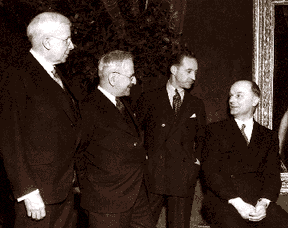
Rivera moved on to New York to complete another commission. An even greater storm followed there. The new commission was from John D. Rockefeller Jr., for the walls of Rockefeller Center. Rivera's design included a Communist demonstration in Wall street, where banners were depicted bearing such legends as "Down With Imperialistic Wars!" "Workers Unite" and "Free Money."
Rockefeller stood the gaff for a time, but when Rivera added a portrait of Lenin he threw in the sponge and ordered the painting destroyed.
In later years, Detroit would name a freeway after Edsel Ford. Yet the Garden Court murals might well be the memorial that the quiet, self-effacing son of Henry Ford would himself consider most fitting. It was ironic that the heir apparent to one of the world's great fortunes should appear in the controversy as the sponsor of the Communist Rivera - but Edsel Ford's lifetime was full of ironies.
It was said that he grew up under the shadow of his father. Nevertheless, he became president of the Ford Motor Co. in 1919 at 25, and it was no mere titular responsibility. From the first day he visited the company offices as a boy, his father saw to it that he was trained to fill the role.
Greenfield Village bears witness to the omnivorous enthusiasm of the elder Ford as a collector of Americana, but he was not greatly attracted to the fine arts. Edsel Ford, on the other hand, played an important role in Detroit's cultural development.
His appointment to the Arts Commission in 1925, extended by Mayor John C. Lodge for seven years, proved a happy choice. He became president of the commission in 1930 and steered the Institute of Arts through the difficult depression years.
Throughout those years, Ford and Valentiner worked in close partnership.
Dr. Valentiner became director of the old museum on East Jefferson in 1924. His monumental task was to make the collection worthy of the $7,000,000 new building. Formerly associated with the Hague museum of Holland and the Kaiser Friedrich Museum in Berlin as well as the Metropolitan Museum of Art in New York, he ranked as a world authority on Italian sculpture, the art of the Middle Ages, oriental art and other fields.
Edsel Ford purchased and donated treasures selected by Valentiner specifically to round out the collection. It might be a Persian silk animal rug of the 16th century, a marble Madonna and Child by the 14th century Italian sculptor Nino Pisano, or a rare sixth century Chinese gilt bronze Matreya, a "Buddha of the Future."
Together, they built for Detroit's future artistic heritage. Their collaboration put the institute well on the way to becoming one of America's great museums.
